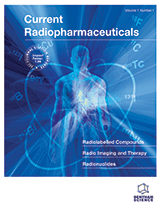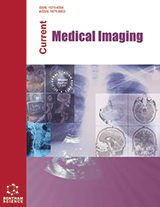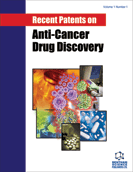Abstract
Over the past several years, Positron Emission Tomography (PET) imaging agents labeled with 68Gallium (68Ga) have undergone a significant increase in clinical utilization. 68Ga is conveniently produced from a germanium-68/gallium-68 (68Ge/68Ga) generator. Because of the compact size and ease of use of the generator, 68Ga labeled compounds may be more cost-effective than PET radioisotopes that are cyclotron-produced. The convenient half-life of 68Ga (T1/2=68 min) provides sufficient radioactivity for various PET imaging applications, while delivering acceptable radiation doses to patients. This chapter summarizes the emerging clinical utilization of 68Ga-based radiotracers in medical imaging.
Keywords: 68Gallium, generator, neuroendocrine tumors, positron emission tomography, somatostatin receptor scintigraphy, PSMA.
Graphical Abstract
Current Radiopharmaceuticals
Title:Gallium-68 in Medical Imaging
Volume: 9 Issue: 3
Author(s): Lucia Martiniova, Louis De Palatis, Elba Etchebehere and Gregory Ravizzini
Affiliation:
Keywords: 68Gallium, generator, neuroendocrine tumors, positron emission tomography, somatostatin receptor scintigraphy, PSMA.
Abstract: Over the past several years, Positron Emission Tomography (PET) imaging agents labeled with 68Gallium (68Ga) have undergone a significant increase in clinical utilization. 68Ga is conveniently produced from a germanium-68/gallium-68 (68Ge/68Ga) generator. Because of the compact size and ease of use of the generator, 68Ga labeled compounds may be more cost-effective than PET radioisotopes that are cyclotron-produced. The convenient half-life of 68Ga (T1/2=68 min) provides sufficient radioactivity for various PET imaging applications, while delivering acceptable radiation doses to patients. This chapter summarizes the emerging clinical utilization of 68Ga-based radiotracers in medical imaging.
Export Options
About this article
Cite this article as:
Martiniova Lucia, Palatis De Louis, Etchebehere Elba and Ravizzini Gregory, Gallium-68 in Medical Imaging, Current Radiopharmaceuticals 2016; 9 (3) . https://dx.doi.org/10.2174/1874471009666161028150654
| DOI https://dx.doi.org/10.2174/1874471009666161028150654 |
Print ISSN 1874-4710 |
| Publisher Name Bentham Science Publisher |
Online ISSN 1874-4729 |
 141
141 27
27
- Author Guidelines
- Bentham Author Support Services (BASS)
- Graphical Abstracts
- Fabricating and Stating False Information
- Research Misconduct
- Post Publication Discussions and Corrections
- Publishing Ethics and Rectitude
- Increase Visibility of Your Article
- Archiving Policies
- Peer Review Workflow
- Order Your Article Before Print
- Promote Your Article
- Manuscript Transfer Facility
- Editorial Policies
- Allegations from Whistleblowers
Related Articles
-
Imaging of Hypoxia Using PET and MRI
Current Pharmaceutical Biotechnology Cancer T Cell Immunotherapy with Bispecific Antibodies and Chimeric Antigen Receptors
Recent Patents on Anti-Cancer Drug Discovery Needle in a Haystack: Targeting Specific Glucuronidases Amid the Human Microbiome
Current Enzyme Inhibition β -Glucans and their Applications in Cancer Therapy: Focus on human studies
Anti-Cancer Agents in Medicinal Chemistry Oncorine, the World First Oncolytic Virus Medicine and its Update in China
Current Cancer Drug Targets Chemotherapy and Molecular Therapy in Non-Melanoma Skin Cancer
Current Cancer Therapy Reviews Cytokine Gene Polymorphisms in Cancer and Inflammatory Disorders
Current Immunology Reviews (Discontinued) Genistein Aglycone: A Dual Mode of Action Anti-Osteoporotic Soy Isoflavone Rebalancing Bone Turnover Towards Bone Formation
Current Medicinal Chemistry A Personalized Approach to Systemic Treatment of Unresectable or Metastatic Pancreatic Adenocarcinoma
Current Pharmacogenomics and Personalized Medicine Recent Advances in Bone Graft Technologies
Recent Patents on Biomedical Engineering (Discontinued) Critical Roles of EGFR Family Members in Breast Cancer and Breast Cancer Stem Cells: Targets for Therapy
Current Pharmaceutical Design Targeted Cancer Therapy; Nanotechnology Approaches for Overcoming Drug Resistance
Current Medicinal Chemistry Practical Aspects in the Use of Biomarkers for the Development of Cancer Vaccines
Current Cancer Therapy Reviews microRNAs in Cancer: Lessons from Melanoma
Current Pharmaceutical Design Future Prospect of RNA Interference for Cancer Therapies
Current Drug Targets Preparation of Therapeutic Dose of <sup>177</sup>Lu-DOTA-TATE Using a Novel Single Vial Freeze-dried Kit: A Comparison with ‘In-situ’ Preparation at Hospital Radiopharmacy
Current Radiopharmaceuticals Advances in Targeting Insulin-like Growth Factor Signaling Pathway in Cancer Treatment
Current Pharmaceutical Design Identification of Novel Potent Inhibitors Against Bcl-xL Anti-apoptotic Protein Using Docking Studies
Protein & Peptide Letters How to Target Activated Ras Proteins: Direct Inhibition vs. Induced Mislocalization
Mini-Reviews in Medicinal Chemistry MicroRNA-34a and its target genes: Key factors in cancer multidrug resistance
Current Pharmaceutical Design






















